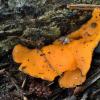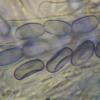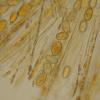
30-11-2025 12:53
 Edvin Johannesen
Edvin Johannesen
White short-stipitate apothecia found on thin twig

30-11-2025 10:47
 William Slosse
William Slosse
I recently found a collection of small Peziza sp.

27-11-2025 12:01
Thomas Læssøehttps://svampe.databasen.org/observations/10496727

27-11-2025 11:46
Thomas Læssøehttps://svampe.databasen.org/observations/10493918

17-09-2025 10:50
Heather MerryleesHi there!I am hoping for any advice on the identif

29-11-2025 08:40
 Andreas Millinger
Andreas Millinger
Hello,on a splintered part of a branch on the grou

28-11-2025 16:45
Nogueira HéctorNovember 23, 2025 Requejo de Sanabria (León) SPAI

25-11-2025 14:24
Thomas Læssøehttps://svampe.databasen.org/observations/10490522

27-11-2025 15:41
Thomas LæssøeSpores brownish, typically 4-celled; 26.8 x 2.4;

27-11-2025 11:31
Thomas LæssøeCollectors notes: Immersed ascomata, erumpent thro
 Good morning,
Good morning,I was given exsiccate of this nice discomycete - could it be Geopyxis (Kotlabaea) delectans? Most characters agree, only the spores are a bit too small and no fireplace was noticed in the field.
A single apotecium about 1,5-2 cm diam., margin raised and a little brownish, no data about the outside in fresh state. Growing on the ground at the edge of a road, basic soil (on serpentinite), warm locality, no fireplace observed.
Microphoto here: http://tmp1.vize.name/myko/indet/ex439.jpg
Excipulum two-layered, medúlla = t. intricata, ectal = t. angularis, about same thickness (up to 80-100 um). Surface cells sometimes covered with light yellow-brown exudate, surface looks like dotted. (The exudate is far too orange on the microphoto.)
Ascus base distinctly forked like in Pulvinula/Geopyxis spp.
Paraphyses filiform, straight, 2 um wide, almost not enlarged at the apex, sometimes branched in upper half, with distinct yellow granules inside even in exsiccate.
Spores smooth, ellipsoid with obtuse ends to almost cylindric, uninucleate, with a few little guttules when young, mature with granulose yellowish contents, (11.7)12–13.1(13.7) × (6.5)6.6–7.3(7.6) µm, Q = 1,7–1,9 (exs. in water).
Eguttulate spores exclude genus Acervus, non-capitate paraphyses and no distinct hairs exclude Pseudaleuria, Boubovia has smaller apo and curved paraphyses. Other Geopyxis spp should have bigger spores, but I saw only G. carbonaria so far.
Thank you in advance for your opinion.
Viktorie
I would exclude G. carbonaria because these species is macros- and microscopically different.
G. delectans is an option althought the spores of your find are a bit too small. Also their form is a bit different (ellipsoid with sligthly tapered ends). Maybe the spores are immature? Mature spores of delectans are not thick-walled. Do you tested also a possible spore ornamentation with cotton blue in lactic acit? And do tested the reaction of the vacuoles in IKI? The reaction should be green.
The genus Geopyxis is difficult. As far as I know, in 2017 a new study about these genus will published, see here: https://www.ncbi.nlm.nih.gov/pubmed/27760850
Best, Uwe
Have you this article on Geopyxis? And in afirmative case, could you send me a pdf of it?
many thanks in advance
enrirubio@asturnatura.com
Best, Uwe

I checked the iodine reaction of paraphyses, it's negative in both IKI and MLZ. But this collection is from 30.july 2016 and when I compared iodine reaction of Aleuria aurantia, collected in the beginning of august, it didn't react either. So I'm not sure, if it really excludes carotenoid presence.
Nevertheless, what other genus could fit besides Geopyxis (and Pyropyxis)? No LBs, no ornamentation, no distinct hairs, dark orange color, and especially inamyloid asci with forked base, ... It's a bad luck there was just the one deformed apo, I hope they'll appear again this year.


